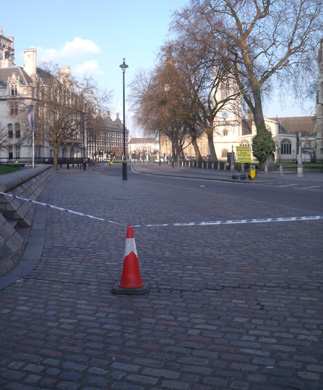St James Tube station felt as normal; outside, the old Scotland Yard looked different, now that it has the workmen in, to turn it into apartments (what else!?). It only felt really strange on Victoria Street; the few people on the pavement and the even less traffic for a weekday afternoon. The whole world knew why it was, but that didn’t make it any less strange, to approach the police tape in front of Westminster Abbey the day after the terror attack of March 22. The way to the Suzy Lamplugh Trust annual personal safety awards passed only yards from the cordon. As the trust’s chief exec Rachel Griffin said before the presentations, it felt an appropriate place to be, that day. While opinions differ after the attack (see pages 27 and 30), the melancholy conclusion as after attacks in Nice and Berlin is that someone intent on using a vehicle as a high-speed weapon will kill; and only something of similar size, or a bullet, will end it. From talking to security and related people, it seems we keep coming back to risk; and appetite for risk. The physical security around Westminster, the overt barriers or more blended street furniture, pushed the attacker onto Westminster Bridge – or so we can presume. Does that mean every London bridge and pavement has to have bollards to prevent another such attack? And as Bill Croft pointed out at the ST17 conference at Nottingham in February, featured in the March issue, in an ‘active shooter’ attack it could take what feels like a long time before armed police intervene.
A theme from last issue and running for a few more is the related disciplines to security management – see ‘site protection’ on page 62. Likewise, lone worker and front-line staff protection is a matter for facilities, safety and risk managers, besides the head of security. As reported last issue, body-worn cameras for security officers and others do appear to reduce conflict, as non-security staff on trains are finding (from page 42). I hope to cover body-worn video some more. Just to say here that as Paul Ratcliffe of Croydon Council has spelt out (page 41), there’s way more to giving front-line workers body-worn cameras and armour than handing out the kit; the users have to be trained, and actually want to use it, and good publicity (or a lack of bad publicity) comes in handy.
Talking of publicity, the second of a series of three articles about Project Servator is on page 36. For three years now – how time flies! – I have been impressed by the attention to detail of Servator. As I say in a summing-up next month, it’s not sensible to go into the nuts and bolts of the tactics, in case that gives the game away to the ‘hostiles’; suffice to say it’s the best shot I have come across at matching quality of protective security with quantity, that remains arguably the hardest to answer question for security managers.










